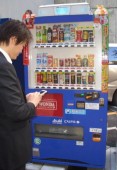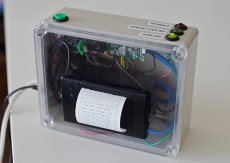Quilting 2.0
Today’s sewing machines are sophisticated embedded systems with exacting precision, automated stitch control, and touch-screen interfaces:
 Photo: Brother International
Photo: Brother International
My Aunt Yetta sewed quilts—and most of her family’s clothes—on an antique treadle sewing machine that was powered by her foot.
The next 50 years of technological innovation added electricity and the zigzag stitch—and that was fine.
One Brother model’s LCD offers a “needle’s-eye view” that lets a quilter line up the work exactly; precision is an important consideration for many quilting techniques. (One look at my own wandering quilting rows shows why.) Other features recognize the distance between the seam line and the edge of the fabric, even on gentle curves. Quilters care about quarter-inch seams because even slight inaccuracies in quilt blocks, of which there may be hundreds, compound themselves across a quilt that’s three meters wide.
The embedded software on a sewing machine’s system board is almost all custom written; You download updates from the manufacturer’s Web site onto a USB key that plugs into the sewing machine. You can also use the USB port to save and copy embroidery designs.
All these features are designed to help amateur quilters get professional results. The high-end sewing machines—which start at about US $6000 and can cost more than $10 000—help quilters work with more speed and accuracy, and best of all, avoid much of the tedium of an essentially repetitive craft.
Most quilters have happily moved into the 21st century. “The sewing machine has opened up the gates of faster creative expression,” says Bonnie Lyn McCaffery, a quilting book author and instructor who’s been quilting for 27 years. McCaffery has learned to create continuous line designs for beautiful bobbin embroidery, using techniques that can’t be duplicated by hand.
Quilting 2.0
Whether it’s mothers and daughters or large quilting bees, quilting has always been a social activity, one in which women (and occasionally men) come together to sew and quilt, sharing experiences and techniques. Thus it’s no surprise that quilting has become a “Web 2.0” activity. Online communities are active and vibrant—and have long ago moved beyond e-mail lists, discussion forums, and their modern equivalents, Facebook and Twitter.
This article originally appeared in print as “A Different Kind of Multithreading.”
Tags: 2.0, craft, embedded, machine, quilt, quilter, quilters, quilting, sewing, technology, web
Trackback from your site.





Comments (3)
Ǩhalil Koros
| #
buy link please.
Reply
Mostafa Dafer
| #
Sorry… I don't know any online store…
Reply
Paddy
| #
I think what you have is wonderful! I do all kinds of picieng and my Aunt does the quilting for me. I take an idea all the time and run with it, idea being where I start. Nothing I have ever made ends up like what the picture looked like to start with. They are far more fabulous in my and the reciepients mind. The first true quilt I made, the class instructor thought I was unsaine with what I chose for fabric. Well, it turned out great and even she had to admit it was nice after all. That was a lot of years ago now, but many quilts later, I am still told I should follow the rules, and so should my quilter. But neither of us do and we both have great sewing businesses. So keep stitching and loving every minute of it!
Reply